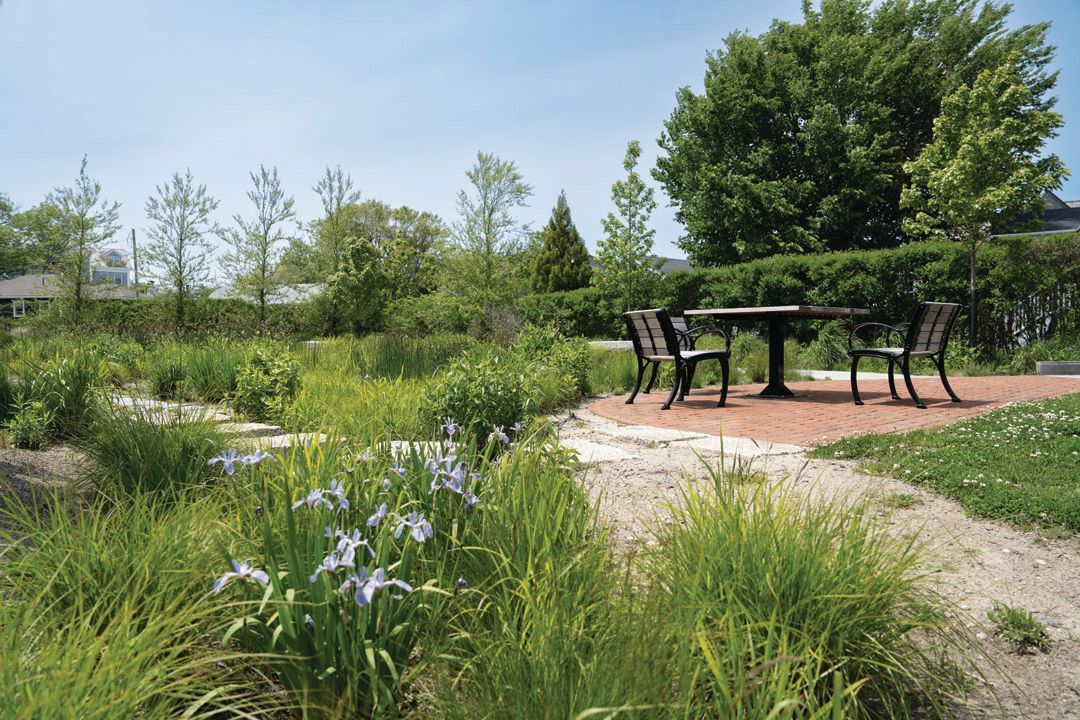Is It Time for the Land Bank to Address the Affordable Housing Crisis?
Written by Brian Bushard
Photography by Kit Noble
Nantucket would not be what itis without the Land Bank. So why, then, has a growing segment of islanders started asking whether the Land Bank has enough conservation land already? The question seemed far-fetched just a decade ago. But now, with over 50 percent of the island preserved thanks in large part to Land Bank’s purchasing power—and as home prices skyrocket—fewer and fewer undeveloped properties remain on the market.
The matter of what the Land Bank does now has become front and center. The question is whether the Land Bank helps address the island’s affordable housing crisis. “The Land Bank thought their mission was to buy land, and now they have enough. What is the mission of the Land Bank is the question,” Nantucket Finance Committee member Jill Vieth said. “We have a population that has grown exponentially in the last 15 years and to meet the needs of the island, we need more land for affordable housing."
The Land Bank was a first-of-its-kind experiment when it was created in 1983. Unlike other conservation organizations on the island, the Land Bank pulls its revenue from a 2% transfer fee on most real-estate purchases. According to its enabling legislation, the properties the Land Bank buys with that money must be used for just three things: conservation, recreation and agriculture.
In its 42 years, it has succeeded beyond all expectations, and is now the second-largest property owner on the island, with nearly 3,500 acres to its name, second only to the Nantucket Conservation Foundation. Those properties include some of Nantucket’s most iconic parks—Gardner Farm, Lily Pond, Smooth Hummocks and the Creeks Preserve. The Land Bank has also created and maintained playgrounds in Sconset and on Old South Road. It owns pickleball and paddle tennis courts, soccer fields and two public golf courses, as well as Moors End Farm and the Sustainable Nantucket lots on Hummock Pond Road.
But with housing prices surging, employers struggling to secure staff housing and renters paying exorbitant amounts for a modest place to live, some islanders are now asking whether it’s time to tap into the Land Bank’s steady income stream to address the lack of affordable housing.

“The Land Bank has been a visionary organization in its first 40 years, but half a billion dollars later and with over 50 percent of the island in conservation collectively between organizations, only a small amount of land is available and undeveloped,” said Tucker Holland, the town’s former housing director. “Now, the question is what should happen with the remaining available land.”
Between the amount of land owned by the Land Bank, other conservation organizations, the town and existing development, less than 3% of Nantucket is available for housing, something that has played a significant role in the high cost of housing production.
Calls for the Land Bank to support affordable housing came to a head at the 2021 Annual Town Meeting. In one of the most controversial articles in recent years, Brooke Mohr—now a member of the Select Board—proposed earmarking a quarter of the Land Bank’s transfer fee revenue to the town for affordable housing projects. But the response to that proposal was an overwhelming no. Mohr’s proposal received more than 120 letters of opposition, led by the Land Bank’s then-Executive-Director Eric Savetsky, who argued at the time the move would “have a drastic negative impact on our ability to acquire new parcels of land for public benefit.” The Nantucket Conservation Foundation even made a rare political statement denouncing the proposal.
In the end, it was rejected by a 572-205 vote—though it did succeed in stirring the pot. “The Nantucket we see today is not the same one that existed when the Land Bank was created,” Mohr said on the floor of town meeting. “The most pressing issue at that time was how to balance development and conservation. Housing for year-rounders was recognized to be an issue then in 1983, but conservation was deemed a higher priority. Since then, the percentage of vacant, undeveloped land has been reduced from 53 percent to less than 4.8 percent today.”

The median Nantucket home price, meanwhile, was a stunning $3.73 million last year, with an average home value of $4.88 million, according to data from Fisher Real Estate. Only a handful of homes remain on the market for under $1 million. The likelihood of a nurse, a school teacher or even a doctor to be able to afford to buy a house on Nantucket has become slim, while service employees looking for a reasonable rental opportunity are left with few practical choices.
As the debate was going down four years ago, the Land Bank was raking in hundreds of millions of dollars from its transfer fee, leveraging a hot housing market in 2021 for a record $48.63 million in revenue, only to be followed by another $46.91 million he following year (the Land Bank received $23.70 million off the transfer fee last year and has so far made $25.4 million in 2025).
“We know there are huge needs of the island, for more housing, a new middle school, for recreation, for coastal resilience—but where is this money going to come from?” Vieth said. “There needs to be more collaboration between the town and the Land Bank and historically there has not been.”
Last year, the Land Bank dropped $26 million on a one-acre beachfront compound east of The Galley restaurant in the organization’s most expensive purchase to date. The idea behind the property—which includes three buildings and had been marketed as a boutique hotel or private club—was to increase public access to the beach, improve handicap accessibility to the area and potentially boost coastal resilience. But the Land Bank drew fire on its acquisition of the property, which opponents argued could have been used for housing.
The property is now one of several where the Land Bank is considering working with housing agencies on a potential collaborative use, Land Bank Executive Director Rachael Freeman said. The buildings could be repurposed as municipal housing units, she said. Though it’s unclear if that would be feasible.
That property also reignited the debate over what the Land Bank should be doing—if anything—to address housing, and whether it has been spending too much money on smaller pocket parks. “I’m not sure just where we can work into affordable housing,” Land Bank Commissioner Allen Reinhard said. “We don’t do affordable housing. We’re not a housing organization. If we can do something that could create a conservation area or even a space where people could sit, like a park, that seems to be the main role the Land Bank might be able to assume."

You don’t have to look very far to find a lesson on how conservation and housing have worked collaboratively. Since 1988, the Martha’s Vineyard Land Bank has partnered with island housing organizations and all six towns on the Vineyard on 17 separate joint purchases where land was split for open space and affordable housing.
“There are plenty of properties that have conservation value in some areas and neutral value in others,” said James Lengyel, executive director of the Martha’s Vineyard Land Bank. Meanwhile, an N Magazine article last year delved into the success of other resort communities, such as Aspen, Colorado, which had the vision to use its transfer fee to build workforce and affordable housing. Aspen—which has less than half the population of Nantucket—now boasts more than 7,000 affordable units, well above Nantucket’s 500 units.
While the Nantucket Land Bank has recently stepped up its efforts to work hand-in-hand with housing agencies, it falls short of the efforts taken on the Vineyard. One reason, Freeman said, is because Martha’s Vineyard’s space constraints are not as acute as they are on Nantucket.
Still, Freeman said the Land Bank has started to take a harder look at how it can support housing projects. One example is the Housing Nantucket affordable housing development on Fairgrounds Road, where the Land Bank is in talks to purchase the front lot on that property and impose a conservation restriction on it, keeping it open space in perpetuity. At another Land Bank property on Orange Street, the Land Bank Commission agreed to provide an easement for an abutting town property slated to become affordable housing.
“Within the boundaries of our act, how can we participate in these conversations?” Freeman asked. “We got here because Nantucket has a number of very important community needs and has very limited space. For me, we started to think through acquisitions priorities and how we partner with housing organizations in the limited space we have.”
Even in these conversations, one point remains clear among all parties involved: The Land Bank should not become a housing developer. To some, there are consequences that come with housing that should also be considered. Reinhard, who has serve on the commission for 23 years, argued that if the Land Bank works with a housing developer, it needs to consider downstream effects, such as parking and traffic. “You can only squeeze so many dwelling units into so many acres of land, and we don’t have that many acres of land,” he said. “We are an island, and we’re a diminishing island at that.”
Housing and conservation can seem antithetical, though it’s hard to argue against either. Nantucket has benefitted from an abundance of pristine, open-space walking trails and wildlife habitat, and it needs more housing, town officials say. The Land Bank was created to protect the island from the prospect of overdevelopment. Now, it faces an acute housing shortage. The question is not whether the Land Bank should cease to exist, but how it allocates its revenues and how it works with housing organizations.
“It feels like a great moment 40 years in and half a billion dollars later to reflect on what the Land Bank set out to accomplish,” Holland said. “The Land Bank is not a housing organization, but are there ways they can lend a hand to address one of the most pressing issues on Nantucket today?”






